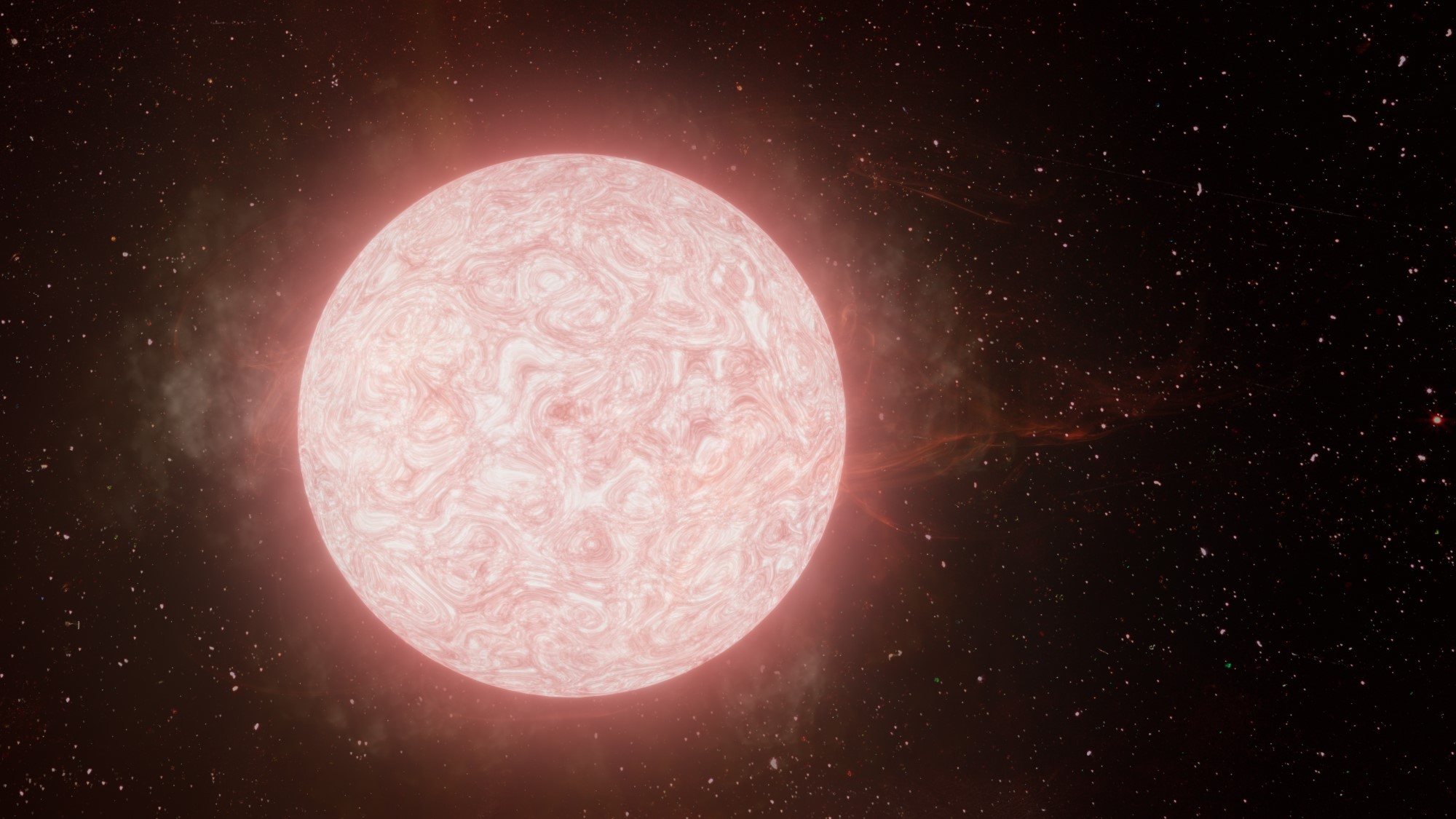Astronomers spot the exposed inner core of an 'oddball' star by accident
The stripped core of a star that was 12 times as massive as the sun was discovered by chance during a stage of stellar evolution that lasts the blink of a cosmic eye.

The exposed core of a massive star has been observed for the first time, a discovery that has been described as purely "serendipitous" by the team that chanced upon it.
Though the cores of stars are where the vast majority of stellar energy is generated by the nuclear fusion of hydrogen into helium, they are usually obscured by the bright outer material that encases them. Stellar cores are exposed only in rare and extremely short-lived circumstances.
Observing such a core in isolation could help astrophysicists better understand the nuclear processes that occur at the heart of stars and how stellar objects evolve.
Related: Alien planets keep their parent stars young by forcing them to 'exercise'
The exposed stellar core in question, a bright previously observed star dubbed Gamma Columbae (γ Columbae). has a mass of between 4 and 5 times that of the sun. The team that uncovered its exposed nature thinks that it was once part of a massive star with as much as 12 times the mass of the sun.
The nature of γ Columbae was uncovered by astronomers, including lead research author Andreas Irrgang of Dr. Karl Remeis-Observatory and the ECAP working group at Friedrich-Alexander University Erlangen-Nuremberg, Bamberg, Germany, as they were observing a group of stars and found that one of them was unusual.
Further investigating the light spectrum emitted by this unusual star the astronomers discovered increased abundances of helium and nitrogen. As these nuclear ashes are usually obscured by outer stellar plasma this indicates γ Columbae's outer envelope is missing.
Breaking space news, the latest updates on rocket launches, skywatching events and more!
"This is probably the most interesting factor of all, in terms of scientific outcome, because all the cores are hidden in the other stars and here we have a naked one, a stripped one, and that will leave a very particular signal in its pulsations," said Norbert Przybilla, head of the Institute for Astro- and Particle Physics at the University of Innsbruck and a co-author of the study, in a statement to Motherboard. "We have to follow up on that."
This led them to question what processes could have stripped γ Columbae of its outer layers reducing its radius considerably and leaving it as a glowing core.
The team thinks that the previously massive star may have recently finished fusing hydrogen to helium in its core with prior research also indicating this is the case despite not hinting at the exposed core nature of γ Columbae.
The end of hydrogen fusion causes the outer layers of a star to 'puff out.' If a binary star companion is pulled into this expanding envelope of stellar material it could cause that material to be ejected.

The team suggests two alternative potential mechanisms that could leave behind an exposed core. The stripping of outer material by a feeding companion binary star, or the evacuation of outer material by stellar winds to expose cores, the latter of which is usually seen in the late stages of incredibly massive stars with a mass between 20 and 25 times that of the sun.
Further study of γ Columbae will be needed to assess the true mechanism behind the exposed nature of the core as the star doesn't exactly fit the parameters that match these suggested mechanisms. "Having a naked stellar core of such a mass is unique so far," Przybilla told Motherboard, adding that the star so far appears to be an "oddball."
One thing the astronomers are fairly sure of is that this stripped core existence is a stage of the life of γ Columbae that will last just around 10,000 years. Though a long period of time in human terms this is no more than the proverbial blink of an eye in cosmic terms.
This further indicates that the discovery of this exposed stellar core is highly fortuitous indeed.
As for the future of this exposed core, the team said that γ Columbae is currently using helium to fuel nuclear fusion creating heavier elements, which it will eventually also begin to fuse. When γ Columbae eventually runs out of fuel for nuclear fusion the energy preventing the core from collapsing under the inward pressure of its own gravity will also cease.
This will lead to gravitational collapse triggering a stripped core supernova and turning γ Columbae into a neutron star — a stellar remnant with the mass of the sun condensed into a diameter around that of the average city on Earth.
The astronomers suggest that a better understanding of γ Columbae could come from studying it using asteroseismology, a field of science that studies the oscillations of stars and how sound waves pass through the plasma that comprises them to study stellar interiors.
The team's research is published in the journal Nature Astronomy.
Follow us on Twitter @Spacedotcom or on Facebook.

Robert Lea is a science journalist in the U.K. whose articles have been published in Physics World, New Scientist, Astronomy Magazine, All About Space, Newsweek and ZME Science. He also writes about science communication for Elsevier and the European Journal of Physics. Rob holds a bachelor of science degree in physics and astronomy from the U.K.’s Open University. Follow him on Twitter @sciencef1rst.
